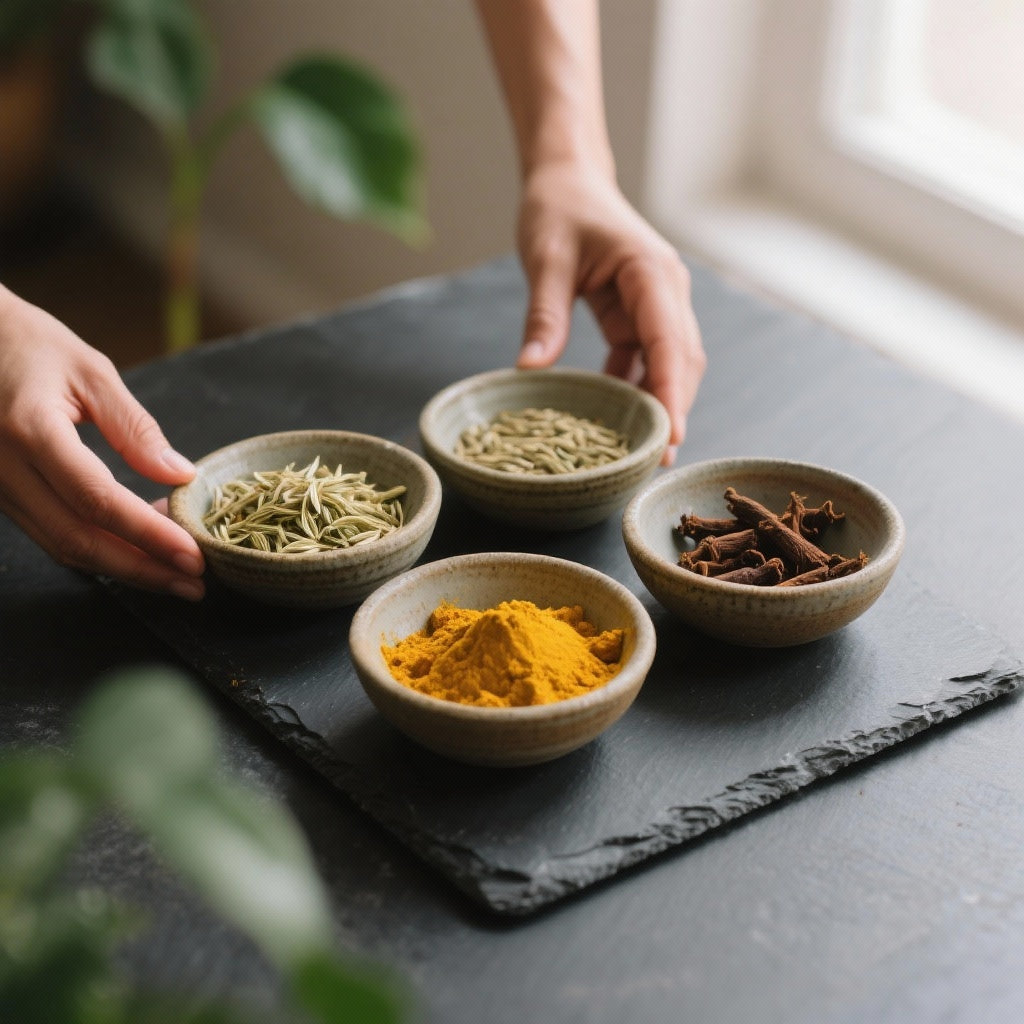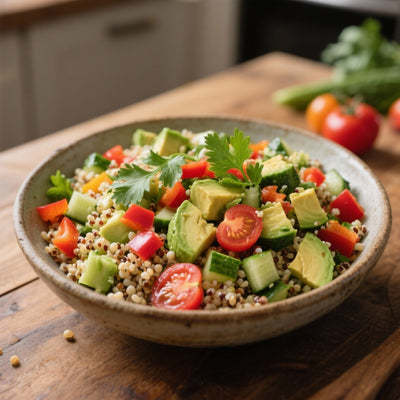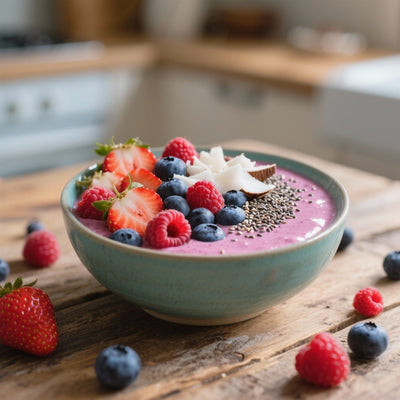Ayurveda and the Doshas: What does this ancient wisdom teach us about balance?
Do you sometimes feel disconnected, tired for no apparent reason, or simply out of balance? In our fast-paced modern world, it's easy to lose touch with our body's natural rhythms. We look for quick fixes to complex problems, treating the symptoms rather than the root cause. What if the key to lasting well-being lay not in a new trend, but in wisdom that's over 5,000 years old?
Ayurveda, or the "science of life," offers us a profoundly personalized and holistic perspective on health. It doesn't ask us to conform to a single mold, but invites us to understand our own nature, our unique constitution. This article is a gateway to this knowledge. Together, we will explore the foundations of Ayurveda, delve into the fascinating concept of the three Doshas —Vata, Pitta, and Kapha—and give you practical tools to identify yours and begin your journey toward harmony.
What is Ayurveda? More than a medicine, a philosophy of life
Originating in India several millennia ago, Ayurveda is considered one of the oldest health systems in the world. The word itself comes from Sanskrit: Ayur meaning "life" and Veda meaning "science" or "knowledge." It is literally the knowledge of life . Its fundamental principle is that optimal health depends on a delicate balance between mind, body, spirit, and the universe around us.
Far from being a mere collection of remedies, Ayurveda is a holistic approach encompassing diet, lifestyle, exercise, meditation, and relationships. Its primary goal is not to cure disease, but to prevent it by maintaining what is called svasthya , a state of dynamic balance and total well-being.
The five great elements: the foundation of everything
According to Ayurveda, the entire universe, including the human body, is composed of five fundamental elements (the Pancha Mahabhutas ):
- Ether (Akasha): Space, emptiness. Associated with sound, it represents the field in which everything manifests.
- Air (Vayu): The principle of movement. It is dry, light, mobile and linked to the sense of touch.
- Fire (Agni): The energy of transformation and metabolism. Hot, pungent, it is linked to sight.
- Water (Jala): The principle of cohesion and fluidity. Liquid, cold, it is linked to taste.
- Earth (Prithvi): Solidity, structure. Heavy, stable, it is linked to the sense of smell.
These five elements are not to be taken literally. They are qualities, energies that combine to form everything that exists. It is from their combination that the three Doshas, the true pillars of Ayurvedic physiology, are born.
The Heart of Ayurveda: Understanding the Three Doshas
The Doshas are the three vital forces or fundamental biological energies that govern all the functions of our body and mind. Each of us possesses these three Doshas, but in a unique proportion, established at birth. This basic constitution is called Prakriti . Understanding your Prakriti is the first step to understanding your strengths, weaknesses, and predispositions.
"Knowing your Ayurvedic constitution is not about putting yourself in a box. It's about receiving a map of your own inner territory to navigate with awareness and wisdom."
Vata: The Energy of Movement
Composed of the elements Air and Ether , Vata is the principle of movement. It is responsible for everything that moves in the body: breathing, blood circulation, nerve impulses, blinking, and even the flow of thoughts.
- Qualities: Dry, light, cold, subtle, mobile, rough.
- In balance: Creative, enthusiastic, quick-witted, flexible, energetic.
- In imbalance: Anxiety, nervousness, insomnia, dry skin, constipation, scattered thoughts, difficulty concentrating.
People with a dominant Vata constitution are often thin, have difficulty gaining weight, and feel the cold more intensely. Their energy comes in waves and their mood can be changeable.
Pitta: The Energy of Transformation
Composed of the elements Fire and Water , Pitta is the principle of transformation. It governs digestion, metabolism, body temperature, nutrient assimilation, and visual perception. It is fire that transforms food into energy and information into knowledge.
- Qualities: Warm, spicy, light, liquid, slightly oily.
- Balanced: Intelligent, focused, good leader, passionate, clear and precise speech.
- In imbalance: Irritability, anger, impatience, inflammation, gastric acidity, skin problems (acne, redness), excessive perfectionism.
Individuals with a Pitta constitution typically have a medium build, good muscle mass, and sensitive skin. They have a voracious appetite and efficient digestion.
Kapha: The Energy of Structure and Stability
Composed of the elements Earth and Water , Kapha is the principle of structure and lubrication. It ensures the body's cohesion, cell hydration, bone strength, immunity, and emotional stability. It is the force that grounds us.
- Qualities: Heavy, slow, cold, oily, stable, soft, dense.
- In balance: Calm, loving, loyal, patient, strong, enduring, good memory.
- In imbalance: Lethargy, weight gain, congestion (sinuses, lungs), water retention, excessive attachment, procrastination.
Kapha constitutions tend to have a more robust bone structure, soft and smooth skin, and a calm and composed nature. They gain weight easily but have great endurance.
How to Determine Your Ayurvedic Constitution?
Identifying your dominant Dosha is a process of self-observation. While an accurate diagnosis should be made by a qualified Ayurvedic practitioner, you can begin to discern your tendencies by honestly answering the following questions. Think about what characterizes you over the long term, not your current state.
1. Your body shape and weight
- Vata: Rather thin, light frame, difficulty gaining weight.
- Pitta: Medium build, athletic, stable weight.
- Kapha: Robust build, heavy build, tendency to gain weight easily.
2. Your skin and hair
- Vata: Dry, thin, cold skin. Dry, fine hair.
- Pitta: Sensitive skin, prone to redness and acne. Fine hair, tendency to gray prematurely.
- Kapha: Thick, oily, smooth skin. Thick, wavy, abundant hair.
3. Your digestion and appetite
- Vata: Variable appetite and digestion, tendency to gas and bloating.
- Pitta: Strong appetite, rapid digestion. Becomes irritable if a meal is skipped.
- Kapha: Moderate appetite, slow digestion. Can skip a meal without any problem.
4. Your mental and emotional tendencies under pressure
- Vata: Tendency towards anxiety, worry, fear.
- Pitta: Tendency towards irritability, anger, and criticism.
- Kapha: Tendency towards withdrawal, lethargy, and attachment.
Remember: You are likely a combination of two Doshas (e.g., Vata-Pitta) or even all three (tridoshic), but one is often more dominant. The goal is to notice the patterns.
The Art of Balance: Practical Tips for Harmonizing Your Doshas
Ayurveda teaches us that "like increases like" and that "opposites balance each other." To restore harmony, you must therefore apply qualities opposite to those of your Dosha when it is in excess.
To Soothe Vata (Dry, Light, Cold)
- Establish a routine: Regularity is the best remedy for Vata. Eat, sleep, and work at fixed times.
- Choose warm and nourishing foods: Consume cooked, hot, creamy and slightly oily foods (soups, stews, root vegetables, whole grains).
- Stay warm: Avoid drafts and the cold. Dress warmly.
- Practice self-massage (Abhyanga): A daily massage with warm sesame oil before showering anchors and nourishes dry Vata skin.
- Move gently: Gentle yoga, tai chi and walking are perfect for calming the nervous system.
To Calm Pitta (Hot, Pungent, Intense)
- Seek freshness: Favor refreshing foods (cucumber, mint, melon, green vegetables) and avoid dishes that are too spicy, acidic or salty.
- Practice moderation: Avoid overwork and competition. Learn to delegate and relax.
- Spend time in nature: Walks by the water or in the forest are very soothing for Pitta fire.
- Don't skip meals: Maintain stable blood sugar levels to avoid irritability.
- Encourage play: Incorporate non-competitive and fun activities into your daily routine to relieve stress.
To stimulate Kapha (Heavy, Slow, Cold)
- Add some movement to your life: Vigorous, daily exercise is essential. Dancing, running, cardio... anything that makes you sweat!
- Eat light and spicy: Opt for light, dry, and warming foods. Use stimulating spices like ginger, black pepper, and turmeric.
- Get up early: Avoid sleeping in, which increases Kapha heaviness. Ideally, get up before 6 a.m.
- Seek out novelty: Step outside your comfort zone. Try new activities, meet new people.
- Practice dry brushing (Garshana): Before showering, brush your body with a silk glove or brush to stimulate circulation and the lymphatic system.











